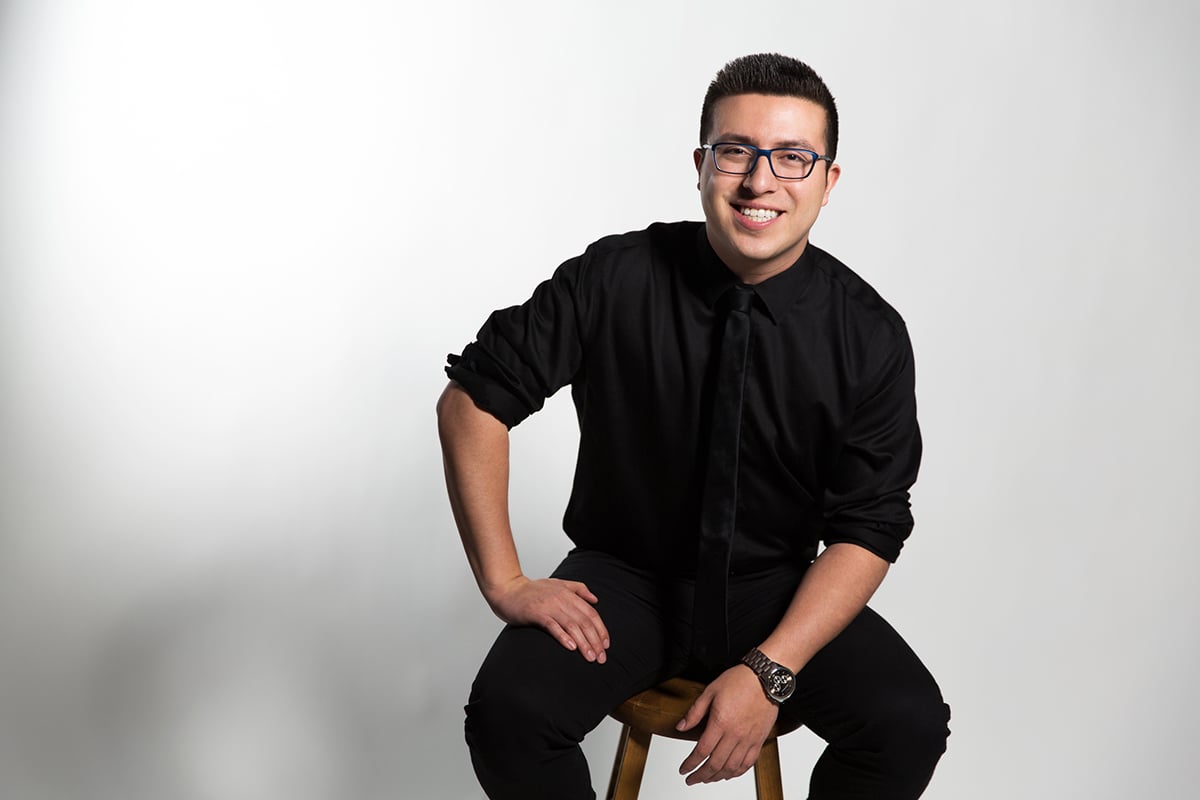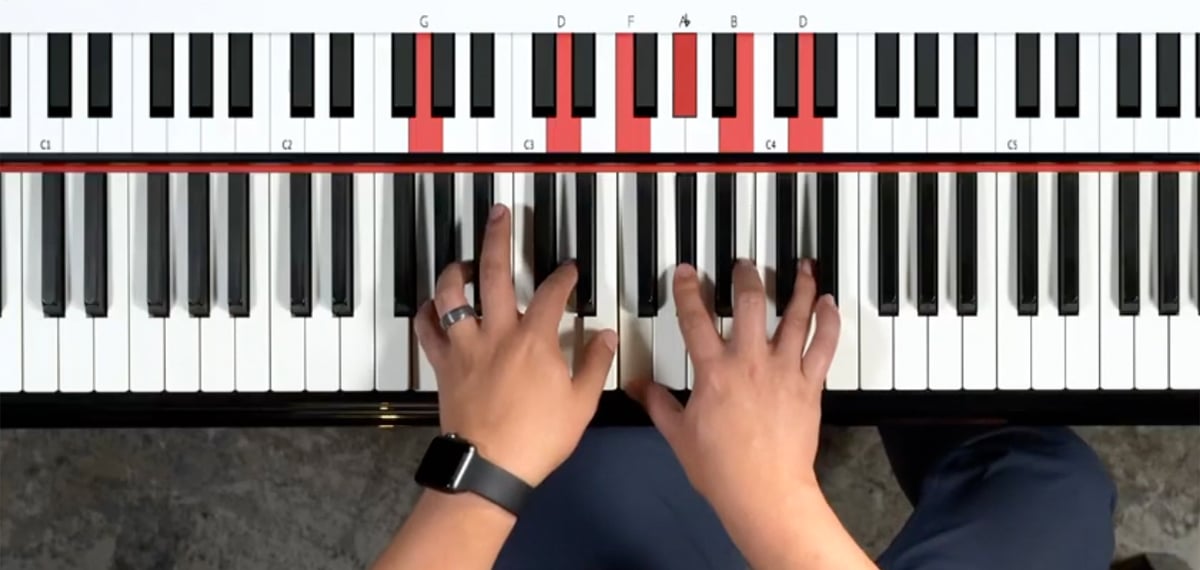“Twinkle Twinkle Little Star” isn’t just a song for kids. You can actually do A LOT with this basic melody.
In this very special mini lesson, guest artist Kevin Castro will show you “Twinkle Twinkle” in five genres. Trust me—it’ll blow your mind! 🤯
Note: this is a more advanced lesson that requires some previous theory knowledge. So get comfortable with chords first. Beginners can try our free Chord Hacks course or read How to Play Piano Chords to get a feel for the basics.
If you feel inspired by this lesson, Kevin Castro is releasing a six-part Latin jazz course with Pianote in November, and you can access this when you become a Pianote Member. Not sure whether you want to become a member yet? No problem! Try Pianote for 90 days and get your money back if you’re not totally satisfied.
Now, before you go spicing up your “Twinkle Twinkle,” practice playing it in its basic form first. To make things simple, here’s the melody and the chords in C Major:

The first style we’ll explore is jazz. Jazz is all about using “jazzy” chords and a swing rhythm. Let’s break this down.
This bass line sounds fancy! What Kevin essentially does here is play a 1-6-2-5-3-6-2-5 progression. This is a very common turnaround pattern in jazz. The specific chords Kevin uses are:
Cmaj7 – A7b9* – Dm9** – G13 – Em7 – A7 – Dm9 – G13
*A: Kevin plays this as a major chord with a flat 9 (A-C#-E-G-Bb)
**Dm: Kevin plays this as a Dm9 (D-F-A-C-E) but a normal Dm7 (D-F-A-C) sounds good too
It sounds jazzy and more complex because Kevin uses approach tones. Approach tones are notes that proceed another note that is either a half or whole step away from your target note. For example, he uses Ab to approach A and Eb to approach D.
What sets jazz apart from, say, classical is the swing rhythm. So avoid playing Mozart-style (everything rhythmically even) and add some syncopation to your playing!

Today, Kevin Castro plays with top artists like JESSIA. But his beginnings were humble. In fact, Kevin started his piano journey by learning from YouTube tutorials as a teen. Take a look at his incredible story and get a mini-lesson in re-harmonizing here.
Next, we’ll kick things up a notch with some old-school rock’n’roll.
A rhythmic, driving bass is a key part of rock. Kevin uses a common rock shuffle pattern here. He alternates the top note of chord shells (like C-G and F-C) with the note immediately above it (A and D, respectively).
Another thing Kevin does are slides. These are little grace notes (twinkles!) that he uses to approach some of the chords. For example, he slides from Eb into a C major triad (C-E-G).
Finally, if you know your blues and pentatonic scales, now is the time to add them! Mix up the notes a little for a sweeping, show-offy run. In fact, this run:
…is just different configurations of a C pentatonic or A blues scale (C-D-Eb-E-G-A).
Now time for some Latin jazz! A lot of this comes from the left hand patterns.
The left hand takes fifths from the C, G, and F triads and alternates between the root and fifth.
To make things a little more interesting, Kevin adds a passing tone once in a while. Like here, when he uses the C# to transition to the C-G pattern and F# to transition to the F-C pattern.
Because Bossa Nova is a jazz genre, you can jazz up your right hand chords by using more sevenths. Flat nine chords are also popular in Bossa Nova, so you can try a G7b9 like this:

Ragtime is a bit more complex and technically difficult, but it’s a slick style to learn once you’ve mastered some basics.
An aspect of ragtime is hitting that bass note of each chord. You can hit a single bass note or use octaves. This requires bigger arm movements, so start slow!
Like slides in the rock genre, slips are when you “slip into” a triad like C-E-G from a semitone like Eb. Or slip into F-A-C from Ab. This gives ragtime tunes that “old Western” feel.
Trills also give your arrangement some additional ragtime factor. In the video, Kevin trills between E and G in the C chord.
If your pinky isn’t strong enough, you can use other fingers, but ideally, use your third and fifth fingers so your thumb is free to hit the root note of the triad.
Kevin does a pretty fancy ending here, moving through a new progression of chords (C > Bb > F/A > Fm/Ab > G), to a blues scale, to a Db13, and he finishes on a C13 chord with an extra arpeggio.
Finally, let’s relax with a ballad. This arrangement is a little simpler and at a more peaceful tempo. Whew!
The left hand in this arrangement plays arpeggios with some inner voices. For example, during the C chord, Kevin plays mainly a power chord (C-G-C) with some Ds and Es sprinkled in.
Overplaying can make your arrangement sound too crowded. Play notes because they sound good and not for the sake of playing notes!
On the right hand, you can harmonize with sixth intervals (for example, C and A). Sixths always sound nice!
The fancy ending here contains an Ab chord that moves to a Bb chord and then back to a C chord. This is sometimes called the “Superbowl Ending.” Extra moving!
As you can see, the piano is an incredibly versatile instrument. (Ahem, it might be the best instrument!) So try out these genres and see what you can come up with.
Lisa Witt has been teaching piano for more than 20 years and in that time has helped hundreds of students learn to play the songs they love. Lisa received classical piano training through the Royal Conservatory of Music, but she has since embraced popular music and playing by ear in order to accompany herself and others. Learn more about Lisa.
/marketing/pianote/promos/april/banner-bg-m.webp)
We use cookies for traffic data and advertising. Cookie Policy »
/marketing/pianote/promos/april/banner-title.webp)